Apparent magnitude - what is it?
With the advent of more precise light-measuring instruments, astronomers have decided to use decimal fractions—for example, 2.75m—to denote magnitudes rather than simply roughly indicating the magnitude as 2 or 3.
Typically, when astronomers talk about magnitudes they mean " apparent magnitude ". As a rule, in such cases, a small Latin letter m is added to the numerical value - for example, 3.24m.
This is a measure of the brightness of a star as seen from Earth, without taking into account the presence of an atmosphere that affects the view.
Today we know stars whose magnitude is brighter than 1m.
For example, Vega , which is the brightest star in the constellation Lyra, has an apparent magnitude of 0. Any star shining brighter than Vega will have a negative magnitude. For example, Sirius , the brightest star in our night sky, has an apparent magnitude of -1.46m.
Note. , absolute magnitude is also used which determines the luminous power of a star, without correction for distance or other factors.
The list shows the brightest stars observed from Earth in the optical range by apparent magnitude . For multiple stars, the total magnitude is given.
| № | Name | Distance, St. years | Apparent value | Celestial hemisphere |
| 1 | Sirius (α Canis Majoris) | 8,6 | -1,46 | South |
| 2 | Canopus (α Carinae) | 310 | -0,72 | South |
| 3 | Toliman (α Centauri) | 4,3 | -0,27 | South |
| 4 | Arcturus (α Bootes) | 36,7 | -0,05 | Northern |
| 5 | Vega (α Lyrae) | 25 | 0,03 | Northern |
| 6 | Chapel (α Auriga) | 42,2 | 0,08 | Northern |
| 7 | Rigel (β Orionis) | 870 | 0,12 | South |
| 8 | Procyon (α Canis Minor) | 11,4 | 0,38 | Northern |
| 9 | Achernar (α Eridani) | 139 | 0,46 | South |
| 10 | Achernar (α Eridani) | 139 | 0,46 | Northern |
Let's move on to a more detailed description of the dozens of the brightest stars in the sky, in descending order of their brightness.
Sirius (α Canis Majoris)
The famous “dog star” (it was not for nothing that J. Rowling called her hero, who turned into a dog, that way), the appearance of which in the sky meant the beginning of vacation for ancient schoolchildren (this word means “dog days”) is one of the closest to the solar system and therefore perfectly visible from almost anywhere on Earth, except the Far North.
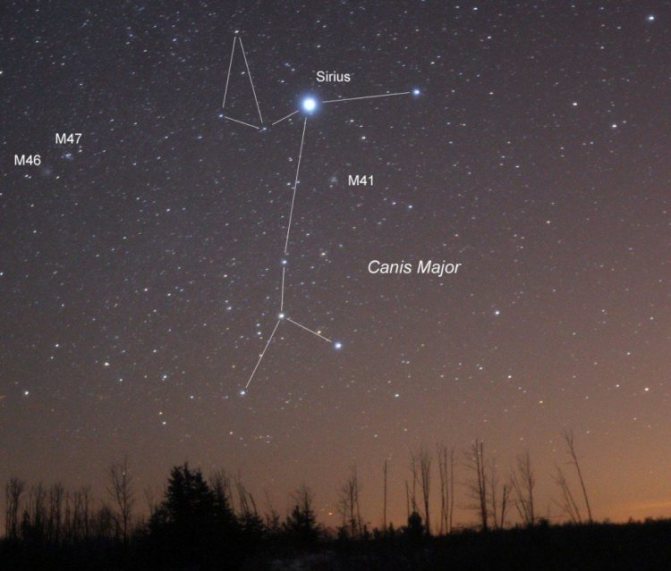
It is now believed that Sirius is a double star. Sirius A is twice as large as the Sun, and Sirius B is smaller. Although millions of years ago, apparently, it was the other way around.
Many peoples have left various legends associated with this star. The Egyptians considered Sirius to be the star of Isis, the Greeks - the dog of Orion taken to heaven, the Romans called him Canicula (“little dog”), in Old Russian this star was called Psitsa.
The ancients described Sirius as a red star, while we observe a bluish glow. Scientists can only explain this by assuming that all ancient descriptions were compiled by people who saw Sirius low above the horizon, when its color was distorted by water vapor.
Be that as it may, now Sirius is the brightest star in our sky, which can be seen with the naked eye even during the day!
It flickers frequently because its bright light can penetrate the lower atmosphere better than that of other stars. It's only 8.6 light-years away, but it's a class A star, twice as massive and 25 times brighter than the Sun.
Finding the star Sirius in the sky
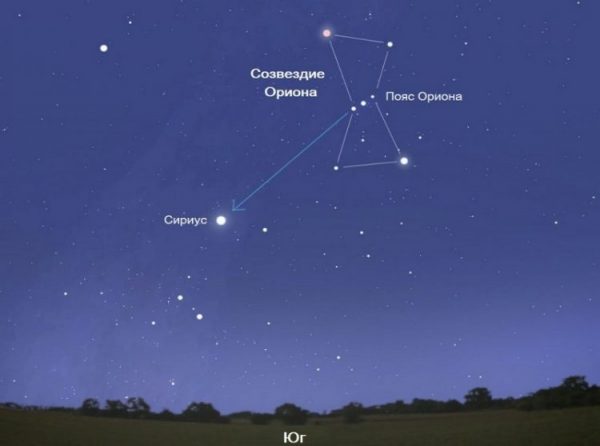
The best time to observe Sirius is winter (for observers in the northern hemisphere), since the Dog Star appears quite early in the evening sky. To find Sirius, use the constellation Orion as a guide, or rather its three belt stars. Draw a line from the leftmost star of Orion's belt with an inclination of 20 degrees in the direction of the southeast.
You can use your own fist as an assistant, which at arm's length covers about 10 degrees of the sky, so you will need about two times the width of your fist.
Canopus (α Carinae)
Supergiant Canopus is 15,000 times brighter than the Sun, and is the second brightest star in the night sky, despite being 310 light-years away.

In absolute terms of luminosity, Canopus is much brighter than Sirius, which, in turn, is much closer to Earth, but appears dimmer due to its distance.
Nowadays, spacecraft use light from Canopus as a guide in outer space - a prime example of this is the Soviet interplanetary stations and Voyager 2.
Canopus is a yellow-white class F super giant star - a star with temperatures between 5500 and 7800 degrees Celsius. It has already exhausted all its hydrogen reserves, and is now processing its helium core into carbon. This helped the star “grow”: Canopus is 65 times larger than the Sun.
If we replaced the Sun with Canopus, this yellow-white giant would devour everything before Mercury's orbit, including the planet itself.
Searching for the star Canopus in the sky
With an apparent magnitude of -0.72m, Canopus is fairly easy to find in the starry sky, but in the northern hemisphere this celestial body can only be seen south of 37 degrees north latitude. Focus on Sirius (read how to find it above), Canopus is located approximately 40 degrees north of the brightest star in our night sky.
Myth 4. The North Star is visible from anywhere on the planet
The North Star is visible only from the northern hemisphere, unless weather conditions, terrain and other factors interfere with this, and in the northern hemisphere it can be seen from almost any place with an open starry sky. From the southern hemisphere, the northern polarissima is visible only near the equator (up to 85 km), either in reflection in the atmosphere due to the phenomenon of refraction, or when climbing mountains or from an airplane. It is not visible in the rest of the Southern Hemisphere.
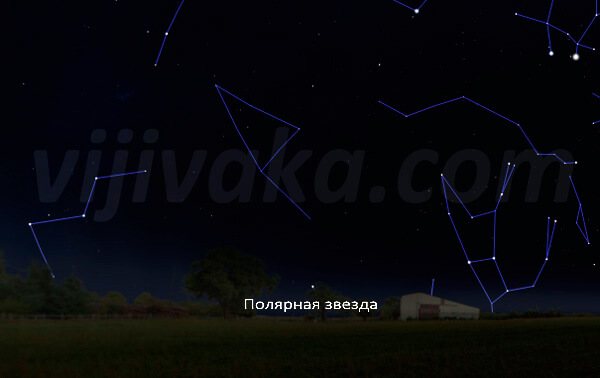
The position of the North Star above the horizon at latitude 4 degrees north (Africa). Even here the star barely appears above the horizon, despite the fact that this is already the northern hemisphere.
This myth is due to the fact that historically the North Star was considered as the main guiding, navigational celestial body. A person who is poorly versed in the matter may decide that since ancient times, people could only use a luminary that could be seen from everywhere as such a guiding star.
Indeed, in the ancient world, where the North Star had already acquired the status of the main navigation star, it was visible from everywhere, at least because ancient developed civilizations were concentrated in the northern hemisphere and people here always saw it. And the subsequent discovery of lands south of the equator, where Kinosura is hidden behind the horizon, could no longer change attitudes towards it.
Fact: The North Star is visible from anywhere in the northern hemisphere of the planet. It is not visible on the southern half of the planet.
Toliman (α Centauri)
This is a double, or rather, even a triple star, but we see two of them as one, and the third, dimmer one, which is called Proxima, as if separately. However, in fact, all these stars are not very bright, but are located not far from us.
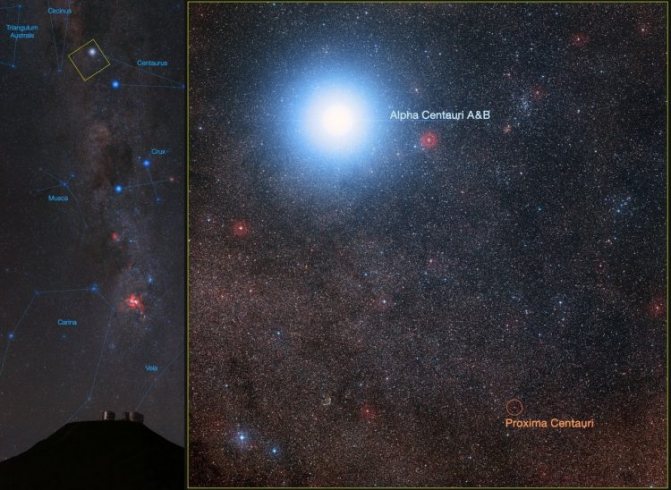
Since Toliman is somewhat similar to the Sun, astronomers have long and persistently been looking for a planet near it, similar to Earth and located at a distance that makes life on it possible. In addition, this system, as already mentioned, is located relatively close, so the first interstellar flight will probably be there.
Science fiction writers Stanislav Lem (creator of the famous Solaris), Asimov, Heinlein devoted pages of their books to this system; The action of the acclaimed film “Avatar” also takes place in the Alpha Centauri system.
On clear summer nights, the Alpha Centauri system shines in the starry sky at a magnitude of -0.27m. True, it is best to observe this unusual three-star system in the southern hemisphere of the Earth, starting from 28 degrees north latitude and further south.
Search for the star Toliman in the sky
Alpha Centauri is located at the very bottom of the Centaurus constellation. Also, to find this three-star system, you can first find the constellation of the Southern Cross in the starry sky, then mentally continue the horizontal line of the cross towards the west, and you will first stumble upon the star Hadar, and a little further Alpha Centauri will shine brightly.
Alpha Centauri
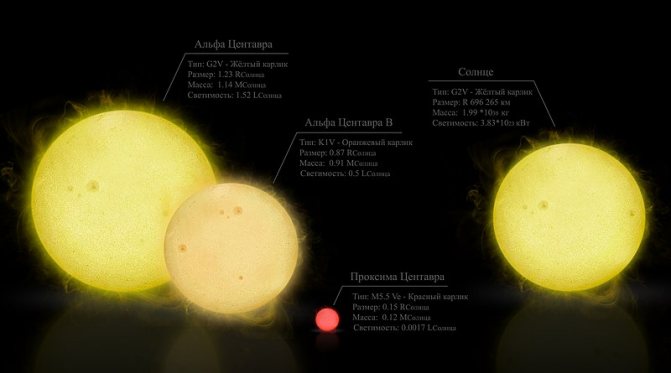
Alpha Centauri
Photo: Comparison of three stars of the Alpha Centauri system and the Sun. Source: wikimedia.org
Alpha Centauri is a triple star system in the constellation Centaurus (Centaurus) and the third brightest in the night sky. The star that we observe and are accustomed to calling Alpha Centauri actually consists of two stars - “Alpha Centauri A” and “Alpha Centauri B”, simply due to the large distance (from the terrestrial point of view the distance is large, but from the point of view of the cosmic whole 4.36 light years), the light of the two stars merges together and we see both stars as one bright one. The third star of this star system is closest to us (the star closest to the Sun) - Proxima Centauri or Alpha Centauri C, but it cannot be seen with the naked eye; it belongs to the red dwarf class.
Both main stars are close in characteristics to our Sun; they move along an elliptical path around a common center of mass.
We cannot distinguish two stars without a telescope because they are too close to each other.
Unfortunately, it is impossible to observe Alpha Centauri from the territory of modern Ukraine, since it is located further south, under the horizon. You can observe the star already at the horizon starting from +29°10′ north latitude, south of Delhi and Kuwait. In the southern hemisphere, with the help of Alpha Centauri, the position of the Southern Cross constellation is determined, which serves as a navigational landmark in space.
Arcturus (α Bootes)
The orange giant, on the evolutionary scale, is somewhere between Procyon and Capella. This is the brightest star in the northern hemisphere , and can be easily found by the “handle” of the Ursa Major bucket. It is only 37 light years away, and only three stars are brighter than it, all located in the southern hemisphere.
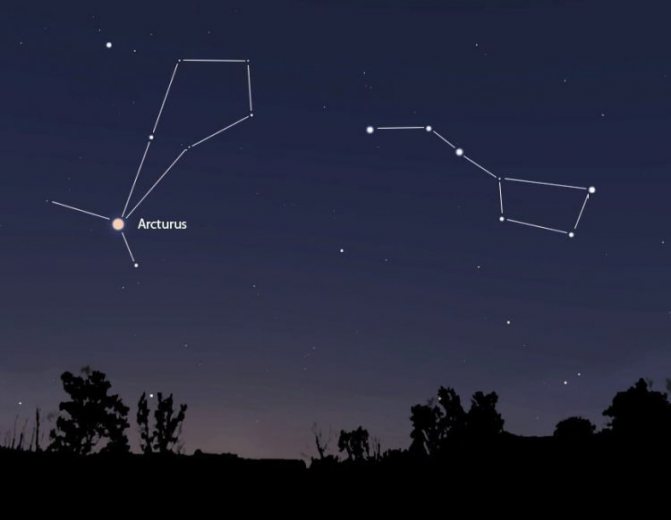
Arcturus is many times brighter than the Sun: if we take into account only the range perceived by the human eye, then more than a hundred times, but if we take the intensity of the glow as a whole, then 180 times! This is an orange giant with an atypical spectrum. Someday our Sun will reach the same stage that Arcturus is at now.
According to one version, Arcturus and its neighboring stars (the so-called Arcturus Stream) were once captured by the Milky Way. That is, all these stars are of extragalactic origin.
Searching for the star Arcturus in the sky
Arcturus is the alpha (i.e. the brightest star) of the spring constellation Bootes. To find the “Ursa Guardian,” you just need to first find the Big Dipper (Ursa Major) and mentally continue the arc of its handle until you come across a bright orange star. This will be Arcturus, a star that forms, within the composition of several other stars, the figure of a kite.
Vega (α Lyrae)
The name “Vega” comes from Arabic and means “soaring eagle” or “soaring predator” in Russian.
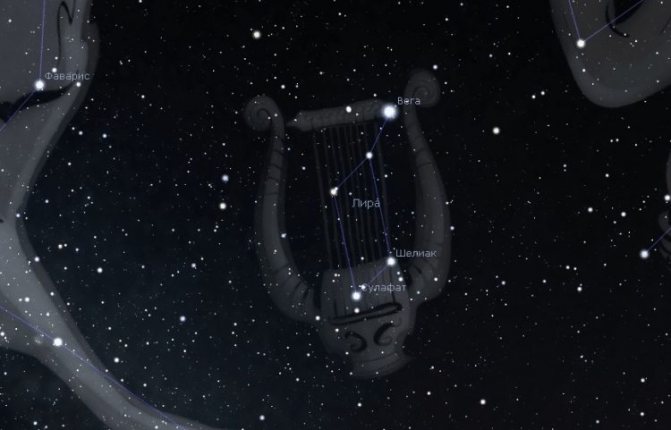
Vega is a hydrogen-burning dwarf star, 54 times brighter than our Sun, while its mass is only 1.5 times greater. Vega is located 25 light years from the Sun, which is relatively small by cosmic standards. It belongs to the main sequence stars, and is one of the brightest class A stars known to us, and also quite young, only 400-500 million years old.
Vega is the first star in the world to be photographed. This event took place on July 16, 1850, and an astronomer from Harvard University acted as a photographer.
Vega's rotation speed is very high (it rotates 137 times faster than the Sun, almost as fast as Achernar), so the star's temperature (and therefore its color) differs at the equator and at the poles. Now we see Vega from the pole, so it appears pale blue to us.
Searching for the star Vega in the sky
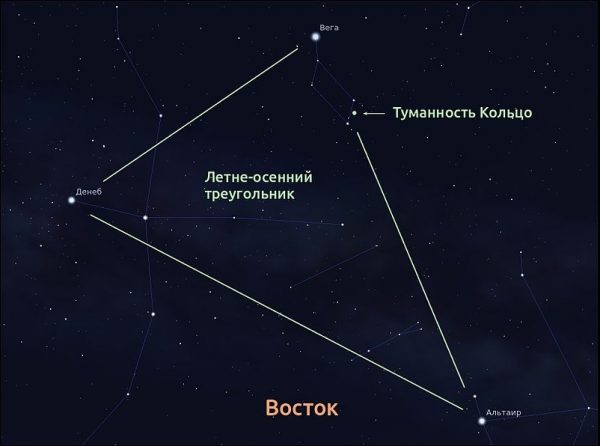
Vega is the second brightest star in the northern hemisphere, so finding it in the starry sky will not be difficult. The easiest way to find Vega is to initially search for the Summer Triangle asterism. This area is ideal for viewing with any size telescope on warm, dark, cloudless summer nights.
With the beginning of June in Russia, already with the onset of the first twilight, the “Summer Triangle” is clearly visible in the sky to the southeast. The upper right corner of the triangle is formed by Vega, the upper left by Deneb, and Altair shines below.
Physical parameters of Vega
Vega is the fifth brightest star in the night sky, only slightly inferior to its “neighbor” - Arcturus, which ranks 4th. However, Canopus and Alpha Centauri (participants No. 2 and 3 of this rating) are not visible from the territory of Russia, and of the three brightest visible (all year round or periodically) objects - Sirius, Arcturus and Vega - the latter takes a confident third place.
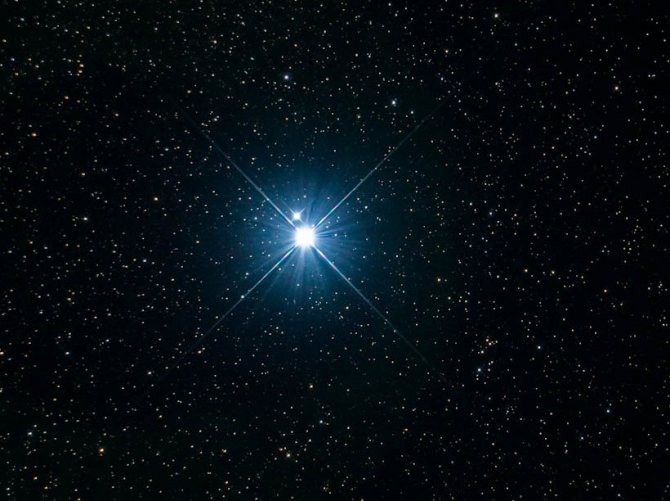
Vega is a hot star of spectral class. Credit: spacegid.com
This star is brighter than the Sun and is clearly visible within a radius of 10 pc from the Earth. In its mass it is 2.1 times greater than the daylight star, in diameter - 2.8 times, in the amount of emitted light - 40 times, but it is about 10 times younger than the Sun.
Main characteristics of Vega:
- type - single;
- spectrum class - A0V;
- color - white with a blue tint;
- The distance to the Sun is about 25 light years.
Content of heavy elements
Vega was born later than the Sun, but has an unusual composition. It contains too few heavy (heavier than helium) chemical elements: 32% of the solar index and only 0.4-0.5% of the mass of the star itself, which is typical for much older stars.
When they die, they eject part of their mass into outer space, and the substance, enriched in metals, becomes part of the next generation of stars. Since this is not typical for Vega, there is a hypothesis that it was born from a hydrogen cloud containing a minimum of heavy elements.
Chapel (α Auriga)
Capella ranks third among the brightest stars in the Northern Hemisphere. Of the stars of the first magnitude (the famous Polaris is only of the second magnitude), Capella is located closest to the North Pole.
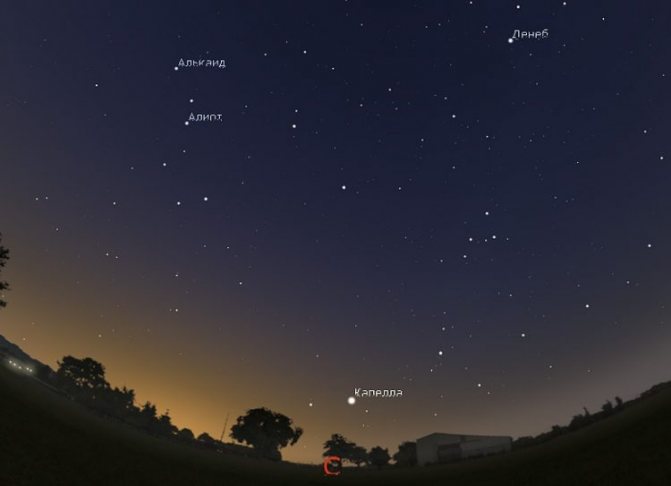
Today it is known that Capella is an incredible system of 4 stars: 2 stars are similar yellow G-class giants, the second pair are much dimmer red dwarf stars.
The brighter of the two, the yellow giant, named Aa, is 80 times brighter and almost three times more massive than our star. The fainter yellow giant, known as Ab, is 50 times brighter than the Sun and 2.5 times heavier. If you combine the glow of these two yellow giants, they will be 130 times more powerful than our Sun.
Finding the star Capella in the sky
If you mentally draw a straight line through the two upper stars that form the bucket of the constellation Ursa Major, you will simply inevitably stumble upon the bright star Capella, which is part of the non-standard pentagon of the constellation Auriga.
For example, if you are at 44 degrees north latitude (Pyatigorsk, Russia) or even further north, you will be able to observe Capella throughout the night: at these latitudes it never goes beyond the horizon
Rigel (β Orionis)
In seventh place in terms of relative (observed by us) brightness is one of the most powerful stars in the Universe with an absolute magnitude of -7, that is, the brightest of the stars located more or less nearby.
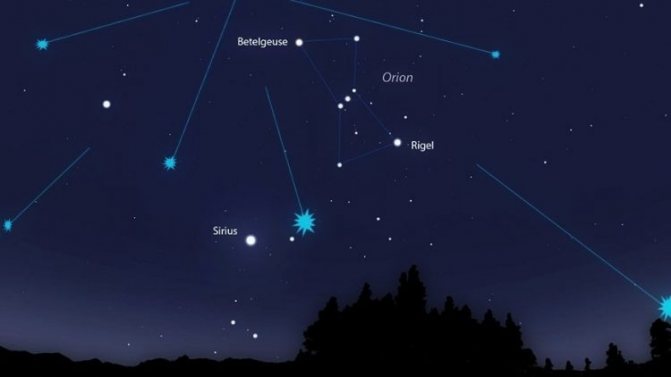
It is 860 light years away, and at a temperature of 12,000 degrees, Rigel is not a main sequence star - it is a rare blue supergiant! It is 130 thousand times brighter than the Sun and 74 times larger in diameter!
The temperature on Rigel is so high that if something were to be at the same distance from it as the Earth is relative to the Sun, this object would immediately turn into a stellar wind.
Rigel has two companion stars, almost invisible in the bright glow of the blue-white supergiant. It is likely that after some time it will turn into a supernova and our galaxy will be illuminated by incredible light from its explosion. However, it could also happen that Rigel could turn into a rare oxygen-neon white dwarf.
Searching for the star Rigel in the sky
First, you should find the constellation Orion (in Russia it is observed throughout the entire territory). This is one of the most well-recognized constellations (only the Big Dipper constellation is more popular). The star Rigel will shine brightly in the lower left corner of the constellation.
How to find in the sky
Finding this star in the sky is not difficult. This can be done in 2 ways: as the brightest element of the Lyra constellation or as a member of the Great Summer Rectangle.
Vega is visible to the naked eye, but through binoculars or even an amateur telescope it looks even more impressive - like a bluish-white star surrounded by several dozen small dim sparkling stars.
Alpha Lyrae
On any summer night or evening in early September, stand facing the southern horizon of the sky and, without turning your head, raise your eyes up. Your gaze will rest on Vega. In this area it will not be the only, but the brightest star.
In the second half of autumn, you need to look for the luminary in the western part of the starry sky, in the spring - in the east, and in winter it will be located in the north, quite low above the horizon in the north.
At the same time, consider the constellation Lyra, to which the star belongs. It is small, but striking, although of its many participants only 5 are clearly visible: Vega and 4 luminaries of the third and fourth magnitude located directly below it in the form of a parallelogram, dimmer than alpha, but still clearly visible.
Vega and the Great Summer Triangle
From May to October, Vega is easy to find as one of the points of a giant asterism. Together with the stars Altair and Deneb, it forms the so-called Great Summer (also known as the Great Summer-Autumn) triangle. It can be seen even with a fleeting glance at the sky, and the figure appears most striking from early July to mid-August. Vega is the brightest element in it: it is located in the upper corner of the asterism.
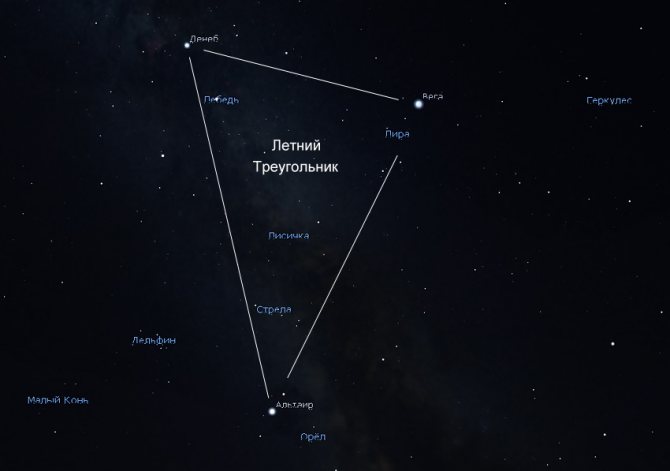
The Great Triangle appears in early summer. Credit: skygazer.ru
Procyon (α Canis Minor)
One of the two “dog stars” is similar to Sirius in that it is the brightest star in the constellation Canis Minor (and Sirius is the brightest star in Canis Major), and in that it is also double.

Procyon A is a pale yellow star about the size of the Sun. It is gradually expanding, and in 10 million years it will become an orange or red giant. According to scientists, the process is already underway, as evidenced by the unprecedented brightness of the star - it is more than 7 times brighter than the sun, although similar in size and spectrum.
Procyon B, its companion, a dim white dwarf, is about the same distance from Procyon A as Uranus is from the Sun.
And there were some mysteries here. Ten years ago, a long-term study of the star was undertaken using an orbiting telescope. Astronomers were eager to get confirmation of their hypotheses. However, the hypotheses were not confirmed, and now scientists are trying to explain what is happening on Procyon in some other way.
Searching for the star Procyon in the sky
To begin with, we find the well-known constellation Orion. In this constellation, in the upper left corner, there is the star Betelgeuse (also included in our rating), mentally drawing a straight line from it in a western direction, you will certainly come across Procyon.
Other bright stars
In total, there are several dozen bright stars in the sky that stand out among others. They are all different - some are not much larger than the Sun, for example, Sirius is the brightest star in the sky. Toliman, Alpha Centauri, is exactly the same as the Sun. Some are stunning giants, such as Betelgeuse.
They are all at different distances, so their brightness does not mean anything. For example, if Sirius were placed instead of the Sun, this white-hot star would simply incinerate the Earth, instantly boiling the oceans and turning them into steam. The red supergiant Betelgeuse would completely devour our planet.
The list of the brightest stars in the earth's sky is presented in the table below.
20 brightest stars in the sky

Facebook
Achernar (α Eridani)
Achernar, translated from Arabic, means “end of the river,” which is quite natural: this star is the southernmost point of the constellation named after the river from ancient Greek mythology, Eridanus.
Achernar is the hottest star in our TOP 10 rating, its temperature varies from 13 to 19 thousand degrees Celsius.
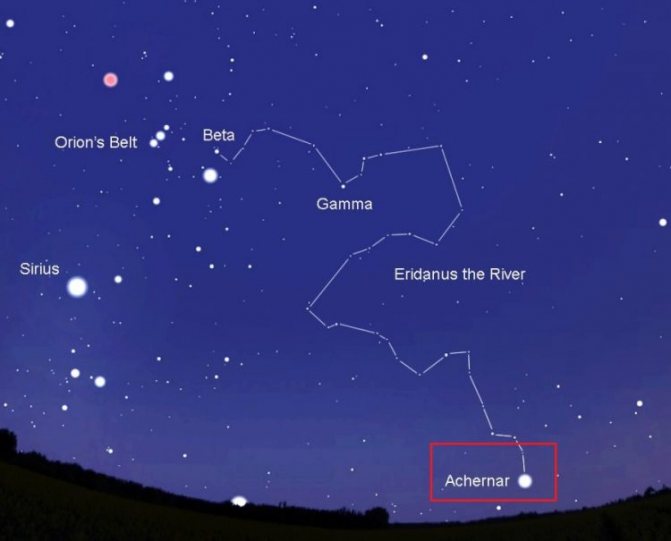
A bright blue star with seven times the mass of the Sun and 3,000 times the brightness. This is one of the fastest rotating stars known to us! It rotates so fast that its equatorial radius is 56% greater than its polar radius, and the temperature at the pole - since it is much closer to the core - is 10,000 K higher. But it is quite far from us, 139 light years away.
Around Achernar you can observe a luminous shell of star matter - this is plasma and hot gas, and the orbit of Alpha Eridani is also very unusual. By the way, Achernar is a double star.
Searching for the star Achernar in the sky
This star can only be observed in the Southern Hemisphere. Unfortunately, this star is not visible on Russian territory. In general, to view Achernar comfortably, you need to be south of 25 degrees North latitude. To find Achernar, mentally draw a straight line in a southerly direction through the stars Betelgeuse and Rigel; the first super-bright star you will see will be Achernar.
Myth 5. The North Star points south
The polar star from the constellation Ursa Minor points north. In the southern hemisphere, its own polarissima, Sigma of the Octantus constellation, points strictly south, but it is much inferior in brightness to Kinosura, therefore it is rarely used in navigation and is not so popular. In fact, it is rarely even called the North Star. When we talk about the North Star, we usually mean North Polarissima, which points due north.
On a note
In general, it is incorrect to say that this or that star is located in the south or north. South and north are directions that are relevant only on planet Earth. Any celestial bodies are located outside the Earth, and very far from it, and saying, for example, that the North Star is in the south is the same as, say, a beetle figuring out which side of the tree the beach is on.
Fact: The most famous North Star points north. Polarissima in the southern hemisphere points south, but is much less commonly called the South Pole Star.
Author: Maxim Chechetov
Betelgeuse (α Orionis)
This star, which has 17 times the mass of our Sun, rounds out the top 10 brightest night stars. Betelgeuse means "hunter's armpit" in Arabic.
Betelgeuse is one of the most mysterious stars in the Universe, because it is capable of changing its size, while its density remains unchanged. The color and brightness of the giant varies at different points.
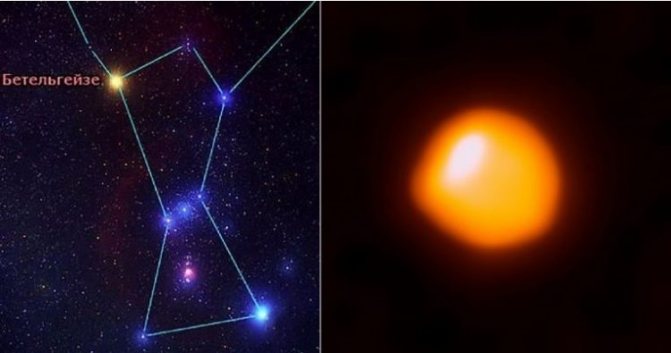
A red giant star in the Orion constellation, Betelgeuse was a bright and hot O-class star until it ran out of hydrogen and switched to helium. Despite its low temperature of 3,500 K, it is more than 100,000 times brighter than the Sun, which is why it is among the ten brightest, despite being 600 light years away.
If we imagine that Betelgeuse becomes our Sun, then everything that is before the orbit of Mars will be absorbed by this giant star!
Scientists expect Betelgeuse to explode in the future, but given that the star is located at a huge distance from the Earth (according to some scientists - 500, according to others - 640 light years), this should not affect us. However, for several months the star can be seen in the sky even during the day.
Searching for the star Betelgeuse in the sky
First, you should find the constellation Orion (in Russia it is observed throughout the entire territory). Like the rest of the constellation, Betelgeuse is visible in the evening sky from December to March in the southern sky. Move your gaze above Orion's belt (a group of three nearby stars) to the bright star in the corner of the constellation - this will be Betelgeuse.
Video
Myth 2. Polaris is the brightest star in the sky
Polaris is far from the brightest star in the night sky. The brightest star in the visible spectrum is Sirius from the constellation Canis Major; several other stars in the night sky are brighter than Polaris, which often leads to orientation errors for beginners: they go to the brightest star, considering it Polaris, and deviate from the north directions.
By the way, this is where the legs of another myth “grow”: Sirius is the North Star. This is also a gross mistake: Sirius has nothing to do with polarissima. Sirius is located in the constellation Canis Major, Polaris is in the constellation Ursa Minor, and the distance between these stars is always significant. Sirius is not the North Star, never has been and never will be.
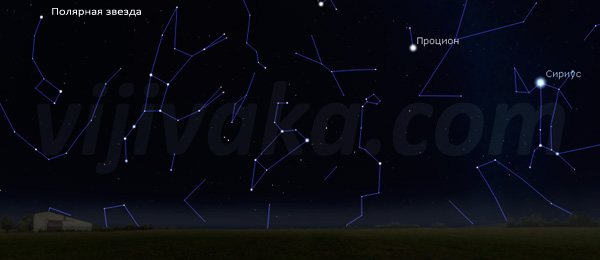
Also a typical winter picture of the starry sky with Kinosura and Sirius
The name of the true northern Pole Star is Kinosura.
On a note
For the same reason, there is a common (albeit to a lesser extent) misconception that Vega is the North Star. Vega is also a bright star, its brightness is greater than the brightness of Polaris. However, this is a completely different luminary that has nothing to do with Kinosura.
Fact: Polaris is not the brightest star in the night sky. The brightness of many stars is significantly greater, and therefore looking for the brightest star to orient yourself is dangerous due to the possibility of error.
And again, from one myth the following follows: since we have already said about the constellations, let us remember the common misconception about the location of the North Star.











